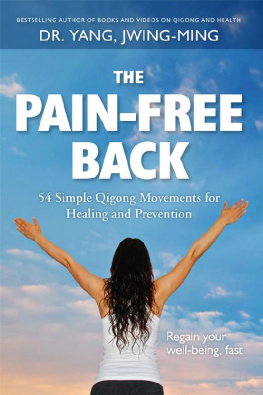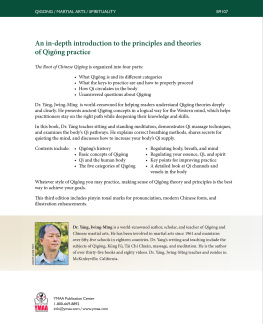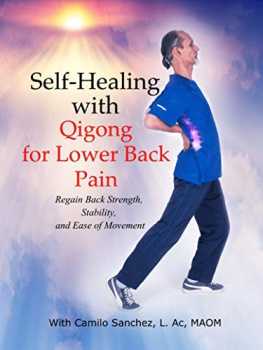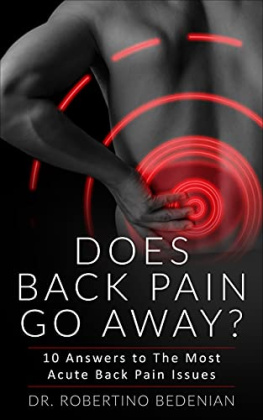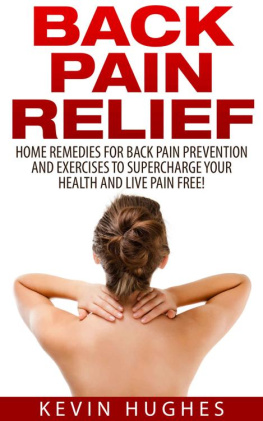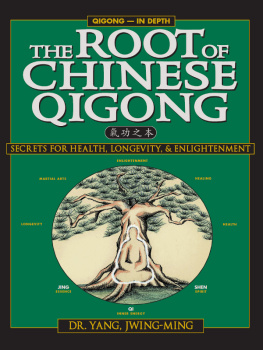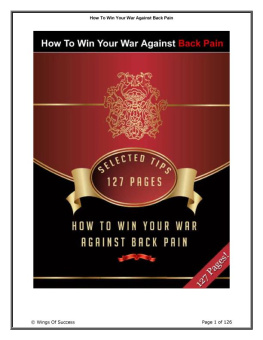DR. YANG, JWING-MING
THE
PAIN-FREE
BACK
54 Simple Qigong Movements for Healing and Prevention
YMAA Publication Center
Wolfeboro, NH USA
YMAA Publication Center, Inc.
PO Box 480
Wolfeboro, New Hampshire, 03894
1-800-669-8892
ISBN: 9781594395376 (print) ISBN: 9781594395383 (ebook)
Copyright 2017 by Dr. Yang, Jwing-Ming
All rights reserved including the right of reproduction in whole or in part in any form.
Edited by Leslie Takao and Doran Hunter
Cover design by Axie Breen
Photos by the author unless noted otherwise
This book typeset in 11.5 pt Minion Pro Regular
Typesetting by Westchester Publishing Services
Illustrations provided by the author unless otherwise noted.
Publishers Cataloging in Publication
Names: Yang, Jwing-Ming, 1946 author.
Title: The pain-free back : 54 easy qigong movements for healing / Dr. Yang, Jwing-Ming.
Other titles: Back pain relief.
Description: Wolfeboro NH USA : YMAA Publication Center, Inc., [2017] | This book is an abridgement of the larger book by Dr. Yang, Jwing-Ming titled Back pain relief: qigong exercises for healing and prevention. This version highlights the exercises you need to treat your back pain, leaving the richness of qigong healing history to the preceding fuller edition.Note from the Publisher.
Identifiers: ISBN: 9781594395376 (print) | 9781594395383 (ebook) | LCCN: 2017949055
Subjects: LCSH: BackacheExercise therapy. | Qi gong. | BackacheAlternative treatment. | BackachePrevention. | BISAC: HEALTH & FITNESS / Pain Management. | BODY, MIND & SPIRIT / Healing / Energy (Qigong, Reiki, Polarity) | HEALTH & FITNESS / Diseases / Musculoskeletal. | HEALTH & FITNESS / Exercise. | SPORTS & RECREATION / Health & Safety.
Classification: LCC: RD771.B217 Y213 2017 | DDC: 617.5/64062dc23
Disclaimer:
The practice, treatments, and methods described in this book should not be used as an alternative to professional medical diagnosis or treatment. The author and publisher of this book are NOT RESPONSIBLE in any manner whatsoever for any injury or negative effects that may occur through following the instructions and advice contained herein.
It is recommended that before beginning any treatment or exercise program, you consult your medical professional to determine whether you should undertake this course of practice.
Table of Contents
Ever since primitive man and woman reared up from their knuckles into the upright posture, the groan of My aching back! has echoed down the corridors of history in workplaces, homes, and hospitals. There are many reasons for this historical fact, a number of which have to do with lifestyle changes, fitness, and the modern environment, all of which were spelled out by Dr. Yang in the preface to his first edition and again in the preface to this revised edition. Not only does the back carry the body, but it also carries many of the psychological tensions stemming from our modern life.
In my psychiatric training, I learned this: to look at posture and body position for clues to a persons mental statethe stooped back whose owner seemed bowed by the weight of depression, the shoulders drawn in and tight and the head retracted like a turtles in anticipation of the blow that comes only in the patients imagination, and similar signs.
In my medical training, I learned this: back pain is one of the hardest conditions to treat effectively. The most common approachesprotracted bed rest, lying on a firm surface, time off from workare extremely difficult for the average person to follow. Noncompliance with the regimen is extremely common. Pain medications work somewhat but risk addiction. Muscle relaxants work somewhat but have troubling side effects. Surgery works as a last resort but can make some cases worse. As a young doctor, my heart would sink whenever a case of lower back pain came into the clinical emergency room, because each one carried with it the specter of the failure of Western medicine.
In my gongfu training with Dr. Yang, I learned this: he is a dedicated scholar and a gifted teacher. He merits the highest praise, however, for his efforts to meld Eastern and Western medical understanding in hopes of achieving greater synergy between the twoin hopes that the two worldviews, combined, will be greater than the sum of their parts.
To this end, he has thoroughly revised the first edition of this book, which featured his comprehensive and wide-ranging exploration of qi theory from its historical to its present context; of the structure and function of the back; and of the Western and Eastern approaches to healing it. In addition, he has added some new concepts for explaining qi and qigong from the Western point of view. These changes further express Dr. Yangs lifelong aim of connecting Chinese and Western medical science. Finally, Dr. Yang has discovered that some of the strenuous exercises described in the first editionwhich might tax persons with serious back paincan be done from the floor instead of from a vertical stance; additional approaches for this posture have been supplied in the current revised edition.
This edition continues the approach of the previous version in that the first chapter alone serves as an excellent and clear introduction to the basic Eastern medical and martial arts idea of qi. So well-structured is this discussion that it requires no previous familiarity with this concept. The remainder of the book employs clear descriptions, relevant illustrations, and well-organized instructions to achieve the goal of providing protection and relief from back pain.
Finally, martial arts are inseparable from morality. In the present context, Dr. Yang compassionately but firmly, like a great sports coach, warns against the moral pitfalls of impatience, laziness, and fear. He encourages readers to strive to stretch their limitscarefully!to master pain and weakness in the back. The book you hold in your hands is a noteworthy contribution to this goal.
Thomas G. Gutheil, MD, professor of psychiatry,
Harvard Medical School
Our lifestyle continues to change from the way it was for over a million years. Now we sleep late, have less labor-intensive work, walk very little, have fewer children in our families, spend more time watching television and computer screens, and receive more radiation. Our bodies cannot adjust in a short period of time; therefore, it is difficult for us to adapt to these new, fast-developing lifestyles. Consequently, many problems occur. We have started to experience more knee pain and weakness, back degeneration and disease, breast cancer, and many other illnesses.
Today, back pain is considered by many to be one of the most serious health problems affecting quality of life. In fact, lower back pain is the second most common cause of pain, surpassed only by headaches, and is second to the common cold as a reason for doctors office visits in the United States. It is estimated that thirty-one million Americans experience back pain at an annual cost of $16 billion to $20 billion in medical treatments and disability payments. The reason there are more back pain cases today than years ago is simply because we now use more machinery to replace our daily muscular work. Our torsos have become significantly weakened.
Therefore, if we are not aware of the problems generated by our new lifestyle and we fail to keep our torsos healthy and fit, we will most likely experience back pain before our fortieth birthdays. The key to maintaining the health of your torso is very simple: exercise correctly and stick with it. Constant exercise will slow down the aging and degeneration of the spine and build up stronger torso muscles to support the body. This is the most basic and important key to preventing back problems.

